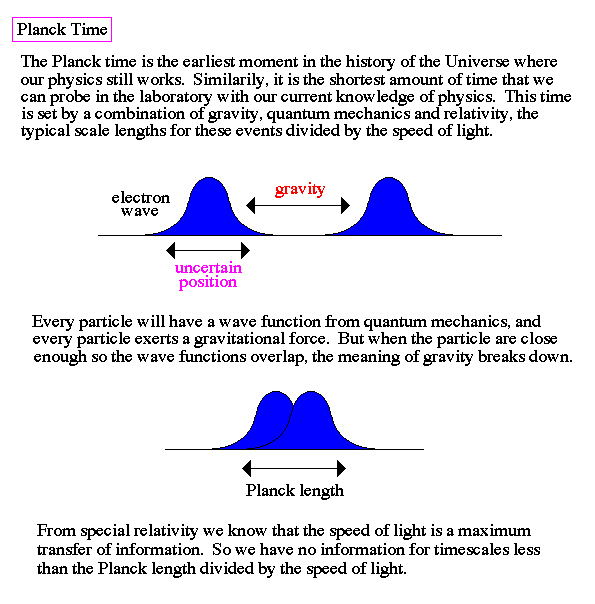
Physics of the early Universe is at the boundary of astronomy and philosophy since we do not currently have a complete theory that unifies all the fundamental forces of Nature at the moment of Creation. In addition, there is no possibility of linking observation or experimentation of early Universe physics to our theories (i.e. its not possible to `build' another Universe). Our theories are rejected or accepted based on simplicity and aesthetic grounds, plus there power of prediction to later times, rather than an appeal to empirical results. This is a very difference way of doing science from previous centuries of research.
Our physics can explain most of the evolution of the Universe after the Planck time (approximately 10-43 seconds after the Big Bang).

However, events before this time are undefined in our current science and, in particular, we have no solid understanding of the origin of the Universe (i.e. what started or `caused' the Big Bang). At best, we can describe our efforts to date as probing around the `edges' of our understanding in order to define what we don't understand, much like a blind person would explore the edge of a deep hole, learning its diameter without knowing its depth.
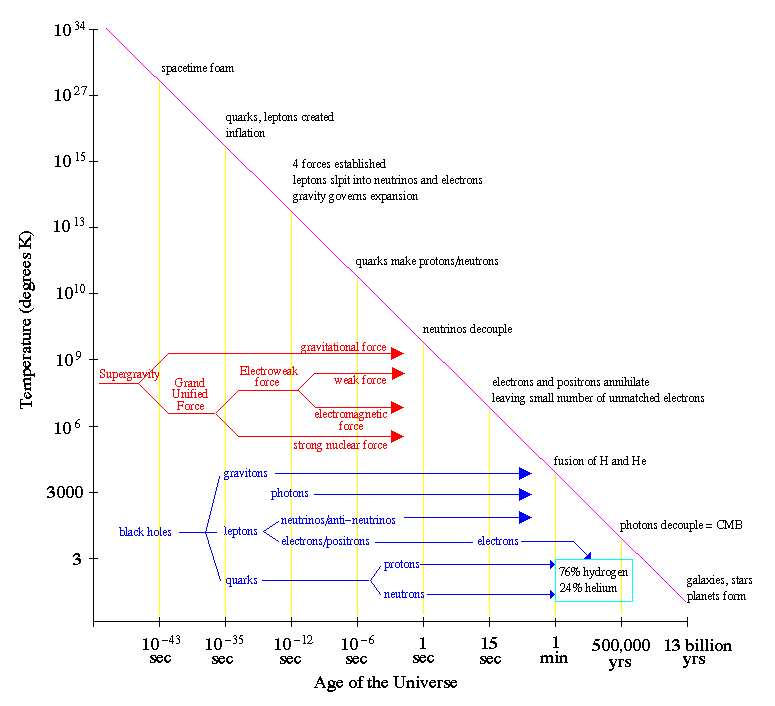
Cosmic Singularity :
One thing is clear in our framing of questions such as `How did the Universe get started?' is that the Universe was self-creating. This is not a statement on a `cause' behind the origin of the Universe, nor is it a statement on a lack of purpose or destiny. It is simply a statement that the Universe was emergent, that the actual of the Universe probably derived from a indeterminate sea of potentiality that we call the quantum vacuum, whose properties may always remain beyond our current understanding.
Extrapolation from the present to the moment of Creation implies an origin of infinite density and infinite temperature (all the Universe's mass and energy pushed to a point of zero volume). Such a point is called the cosmic singularity.
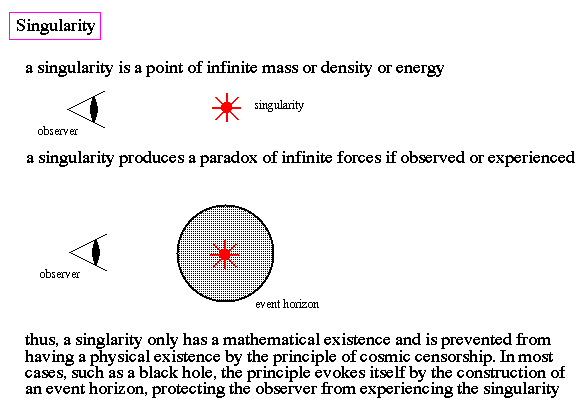
Infinites are unacceptable as physical descriptions, but our hypothetical observers back at the beginning of time are protected by the principle of cosmic censorship. What this means is that singularities exists only mathematically and not as a physical reality that we can observe or measure. Nature's solution to this problem are things like the event horizon around black holes. Barriers built by relativity to prevent observation of a singularity.
Quantum Vacuum:
The cosmic singularity, that was the Universe at the beginning of time, is shielded by the lack of any physical observers. But the next level of inquiry is what is the origin of the emergent properties of the Universe, the properties that become the mass of the Universe, its age, its physical constants, etc. The answer appears to be that these properties have their origin as the fluctuations of the quantum vacuum.
The properties of the Universe come from `nothing', where nothing is the quantum vacuum, which is a very different kind of nothing. If we examine a piece of `empty' space we see it is not truly empty, it is filled with spacetime, for example. Spacetime has curvature and structure, and obeys the laws of quantum physics. Thus, it is filled with potential particles, pairs of virtual matter and anti-matter units, and potential properties at the quantum level.
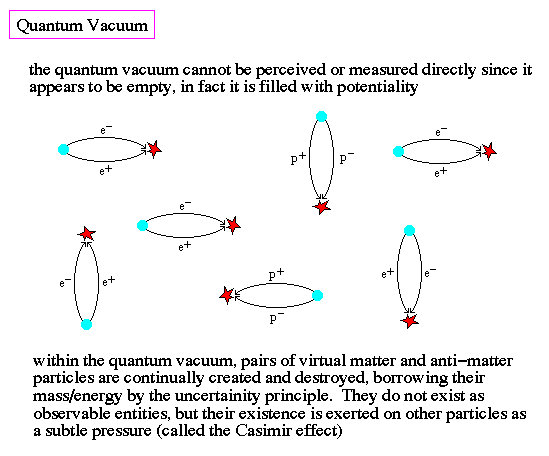
The creation of virtual pairs of particles does not violate the law of conservation of mass/energy because they only exist for times much less than the Planck time. There is a temporary violation of the law of conservation of mass/energy, but this violation occurs within the timescale of the uncertainty principle and, thus, has no impact on macroscopic laws.
The quantum vacuum is the ground state of energy for the Universe, the lowest possible level. Attempts to perceive the vacuum directly only lead to a confrontation with a void, a background that appears to be empty. But, in fact, the quantum vacuum is the source of all potentiality. For example, quantum entities have both wave and particle characteristics. It is the quantum vacuum that such characteristics emerge from, particles `stand-out' from the vacuum, waves `undulate' on the underlying vacuum, and leave their signature on objects in the real Universe.
In this sense, the Universe is not filled by the quantum vacuum, rather it is `written on' it, the substratum of all existence.
With respect to the origin of the Universe, the quantum vacuum must have been the source of the laws of Nature and the properties that we observe today. How those laws and properties emerge is unknown at this time.
Quantum Fluctuations :
The fact that the Universe exists should not be a surprise in the context of what we know about quantum physics. The uncertainty and unpredictability of the quantum world is manifested in the fact that whatever can happen, does happen (this is often called the principle of totalitarianism, that if a quantum mechanical process is not strictly forbidden, then it must occur).
For example, radioactive decay occurs when two protons and two neutrons (an alpha particle) leap out of an atomic nuclei. Since the positions of the protons and neutrons is governed by the wave function, there is a small, but finite, probability that all four will quantum tunnel outside the nucleus, and therefore escape. The probability of this happening is small, but given enough time (tens of years) it will happen.
The same principles were probably in effect at the time of the Big Bang (although we can not test this hypothesis within our current framework of physics). But as such, the fluctuations in the quantum vacuum effectively guarantee that the Universe would come into existence.
Planck Era :
The earliest moments of Creation are where our modern physics breakdown, where `breakdown' means that our theories and laws have no ability to describe or predict the behavior of the early Universe. Our everyday notions of space and time cease to be valid.
Although we have little knowledge of the Universe before the Planck time, only speculation, we can calculate when this era ends and when our physics begins. The hot Big Bang model, together with the ideas of modern particle physics, provides a sound framework for sensible speculation back to the Planck era. This occurs when the Universe is at the Planck scale in its expansion.

Remember, there is no `outside' to the Universe. So one can only measure the size of the Universe much like you measure the radius of the Earth. You don't dig a hole in the Earth and lower a tape measure, you measure the circumference (take an airplane ride) of the Earth and divide by 2 pi (i.e. C = 2 x pi x radius).
The Universe expands from the moment of the Big Bang, but until the Universe reaches the size of the Planck scale, there is no time or space. Time remains undefined, space is compactified. String theory maintains that the Universe had 10 dimensions during the Planck era, which collapses into 4 at the end of the Planck era (think of those extra 6 dimensions as being very, very small hyperspheres inbetween the space between elementary particles, 4 big dimensions and 6 little tiny ones).
During the Planck era, the Universe can be best described as a quantum foam of 10 dimensions containing Planck length sized black holes continuously being created and annihilated with no cause or effect. In other words, try not to think about this era in normal terms.
Unification:
One of the reasons our physics is incomplete during the Planck era is a lack of understanding of the unification of the forces of Nature during this time. At high energies and temperatures, the forces of Nature become symmetric. This means the forces resemble each other and become similar in strength, i.e. they unify.
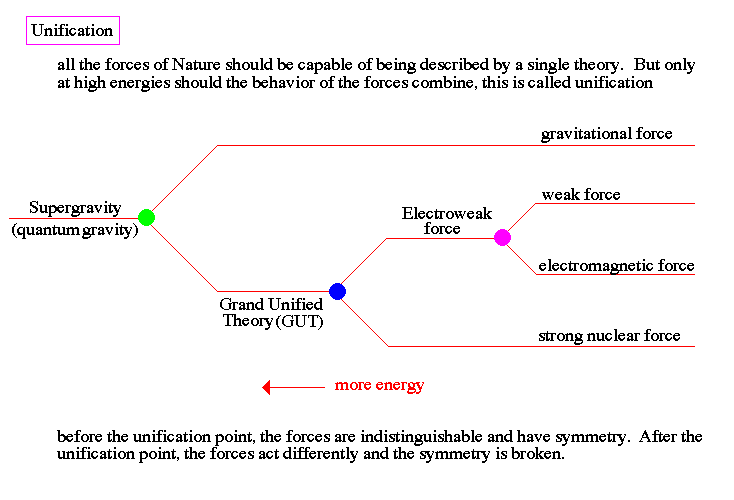
An example of unification is to consider the interaction of the weak and electromagnetic forces. At low energy, photons and W,Z particles are the force carriers for the electromagnetic and weak forces. The W and Z particles are very massive and, thus, require alot of energy (E=mc2). At high energies, photons take on similar energies to W and Z particles, and the forces become unified into the electroweak force.
There is the expectation that all the nuclear forces of matter (strong, weak and electromagnetic) unify at extremely high temperatures under a principle known as Grand Unified Theory, an extension of quantum physics using as yet undiscovered relationships between the strong and electroweak forces.
The final unification resolves the relationship between quantum forces and gravity (supergravity).
In the early Universe, the physics to predict the behavior of matter is determined by which forces are unified and the form that they take. The interactions just at the edge of the Planck era are ruled by supergravity, the quantum effects of mini-black holes. After the separation of gravity and nuclear forces, the spacetime of the Universe is distinct from matter and radiation.
Spacetime Foam :
The first moments after the Planck era are dominated by conditions were spacetime itself is twisted and distorted by the pressures of the extremely small and dense Universe.
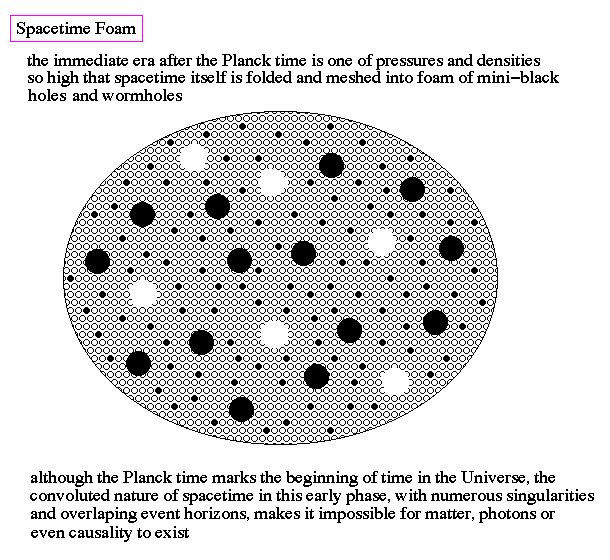
Most of these black holes and wormholes are leftover from the Planck era, remnants of the event horizon that protected the cosmic singularity. These conditions are hostile to any organization or structure not protected by an event horizon. Thus, at this early time, black holes are the only units that can survive intact under these conditions, and serve as the first building blocks of structure in the Universe, the first `things' that have individuality.
Based on computer simulations of these early moments of the Universe, there is the prediction that many small, primordial black holes were created at this time with no large black holes (the Universe was too small for them to exist). However, due to Hawking radiation, the primordial black holes from this epoch have all decayed and disappeared by the present-day.
Matter arises at the end of the spacetime foam epoch as the result of strings, or loops in spacetime. The transformation is from ripping spacetime foam into black holes, which then transmute into elementary particles. Thus, there is a difference between something of matter and nothing of spacetime, but it is purely geometrical and there is nothing behind the geometry. Matter during this era is often called GUT matter to symbolize its difference from quarks and leptons and its existence under GUT forces.
Hawking Radiation:
Hawking, an English theoretical physicist, was one of the first to consider the details of the behavior of a black hole whose Schwarzschild radius was on the level of an atom. These black holes are not necessarily low mass, for example, it requires 1 billion tons of matter to make a black hole the size of a proton. But their small size means that their behavior is a mix of quantum mechanics rather than relativity.
Before black holes were discovered it was know that the collision of two photons can cause pair production. This a direct example of converting energy into mass (unlike fission or fusion which turn mass into energy). Pair production is one of the primary methods of forming matter in the early Universe.

Note that pair production is symmetric in that a matter and antimatter particle are produced (an electron and an anti-electron (positron) in the above example).
Hawking showed that the strong gravitational gradients (tides) near black holes can also lead to pair production. In this case, the gravitational energy of the black hole is converted into particles.
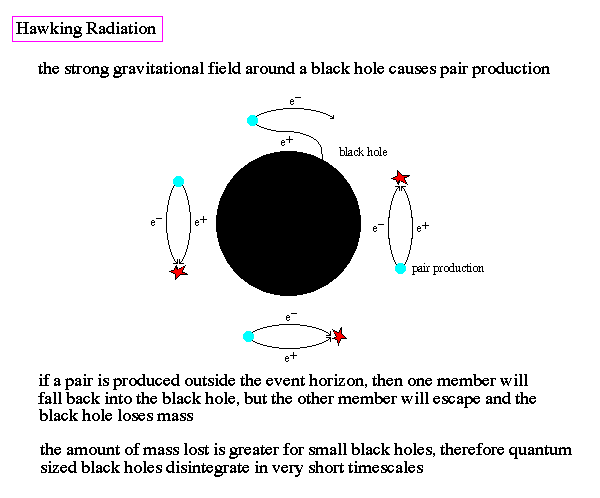
If the matter/anti-matter particle pair is produced below the event horizon, then particles remain trapped within the black hole. But, if the pair is produced above the event horizon, it is possible for one member to fall back into the black hole, the other to escape into space. Thus, the black hole can lose mass by a quantum mechanical process of pair production outside of the event horizon.
The rate of pair production is stronger when the curvature of spacetime is high. Small black holes have high curvature, so the rate of pair production is inversely proportional to the mass of the black hole (this means its faster for smaller black holes). Thus, Hawking was able to show that the mini or primordial black holes expected to form in the early Universe have since disintegrated, resolving the dilemma of where all such mini-black holes are today.